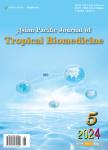Nosocomial infections and their control strategies
Nosocomial infections and their control strategies作者机构:University of Lahore National Academy of Young Scientists (NAYS) University of the Punjab Department of Biomedical Sciences King Edward Medical University Department of NeuroscienceSISSA Trieste Italy
出 版 物:《Asian Pacific Journal of Tropical Biomedicine》 (亚太热带生物医学杂志(英文版))
年 卷 期:2015年第5卷第7期
页 面:505-509页
学科分类:12[管理学] 1204[管理学-公共管理] 120402[管理学-社会医学与卫生事业管理(可授管理学、医学学位)] 1004[医学-公共卫生与预防医学(可授医学、理学学位)] 10[医学]
主 题:Hospital-acquired infection Antibiotics Control strategies Surveillance
摘 要:Nosocomial infections are also known as hospital-acquired/associated infections. National Healthcare Safety Network along with Centers for Disease Control for surveillance has classified nosocomial infection sites into 13 types with 50 infection sites, which are specific on the basis of biological and clinical criteria. The agents that are usually involved in hospitalacquired infections include Streptococcus spp., Acinetobacter spp., enterococci, Pseudomonas aeruginosa, coagulase-negative staphylococci, Staphylococcus aureus, Bacillus cereus, Legionella and Enterobacteriaceae family members, namely, Proteus mirablis, Klebsiella pneumonia, Escherichia coli, Serratia marcescens. Nosocomial pathogens can be transmitted through person to person, environment or contaminated water and food, infected individuals, contaminated healthcare personnel s skin or contact via shared items and surfaces. Mainly, multi-drug-resistant nosocomial organisms include methicillin-resistant Staphylococcus aureus, vancomycin-resistant enterococci, Pseudomonas aeruginosa and Klebsiella pneumonia, whereas Clostridium difficile shows natural resistance. Excessive and improper use of broadspectrum antibiotics, especially in healthcare settings, is elevating nosocomial infections, which not only becomes a big health care problem but also causes great economic and production loss in the community. Nosocomial infections can be controlled by measuring and comparing the infection rates within healthcare settings and sticking to the best healthcare practices. Centers for Disease Control and Prevention provides the methodology for surveillance of nosocomial infections along with investigation of major outbreaks. By means of this surveillance, hospitals can devise a strategy comprising of infection control practices.



